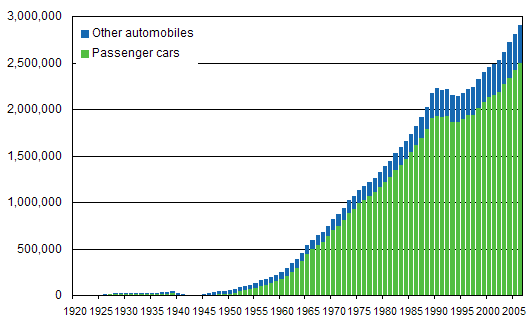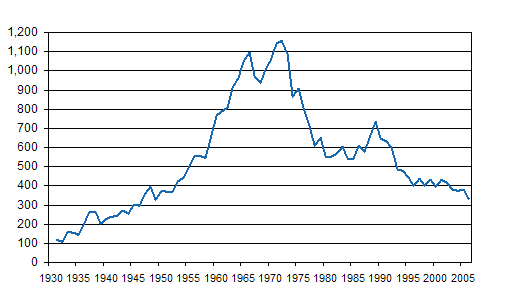A century of motoring in Finland
The history of motoring started in Finland in the year 1900 when the first passenger cars were bought into the country. At the end of 2006, there were nearly three million automobiles in Finland and a total of 52.2 billion kilometres were driven with them.
The first automobiles arrived in Finland in 1900: a Mercedes Simplex bought by Chamberlain Hjalmar Linder and a Benz Velo Comfortable bought by businessman Victor Forselius. The first driving licence in Finland was granted to businessman Yrjö Weilin in 1907. At first, only one type of driving licence was granted in the country, a "certificate of a right to drive", which entitled the bearer to drive any type of automobile. A permission to drive was sought from a vehicle inspector and could be granted to a person over the age of 18 who was known to be sober, regular and reliable, as well as fully acquainted with the construction, maintenance and steering of an automobile.
Passenger car trade was deregulated in 1962
The vehicle register was established in 1907 and was initially maintained by the police. Automobiles grew quickly common in the largest towns and at the beginning of the 1920s there were already 1,800 automobiles and 800 motor cycles in Finland. This progress of motorisation was interrupted in Finland by the Winter War that started in November 1939 and the Continuation War that followed it. The war years taxed the automobile stock substantially so that it contracted from 29,000 to 6,230 during them.
After 1945, the number of passenger cars began to grow again even though imports were controlled and importing of automobiles remained subject to licence right up to 1962. In spite of the Energy Crisis of the 1970s, the automobile stock continued to grow rapidly and reached the one million mark in 1976. It was not until the economic recession of the early 1990s that the number of automobiles temporarily fell in Finland. The growth in the stock of passenger cars resumed after the recession and the two million passenger car mark was passed in 1998. In 2006, there were altogether 2.5 million passenger cars in the country.
Number of registered automobiles 1922-2006

Troubled start for coach transport
Coach transport service was started on the line between Turku and Uusikaupunki in the southwest of Finland in December 1905, when an omnibus of the Scheibler make departed on its maiden trip from near the cathedral of Turku. However, the engine of the coach broke down after 60 kilometres in Laitila and the coach had to be town by four horses to its destination of Uusikaupunki on the next day. Travelling by coach was not very popular in the early days and the reliability of the vehicles was poor. It was not until the early 1920s that vehicles were technically advanced enough to allow starting of regular line services and by 1925 the number of coaches had grown to over 1,300. At the end of 2006, buses and coaches in the vehicle register numbered 11,189.
The first steam-powered lorry was bought into Finland in either 1906 or 1907. The number of lorries grew fast right up to1959, when the vehicle register contained over 46,000 of them. From then on the stock of lorries grew slowly but steadily up to the years of the economic recession of the early 1990s when it shrunk from 55,000 to 45,000 within a couple of years. Rapid growth of the stock resumed after the recession. At the end of 2006, there were 91,465 lorries in Finland and 38 per cent of them operated for hire or reward.
The growth in the number of registered vehicles does not give any indication of how the transport capacity has developed. The sizes and weights of lorries, in particular, have grown hugely since the beginning of last century. In 1923, the maximum permissible gross vehicle weight was seven tonnes. Maximum permissible gross vehicle weights have been reviewed several times since then, so that at the moment the maximum is 60 tonnes, in other words, more than eight-fold compared to 1923.
First motorway in the 1960s
At the beginning of last century roads in Finland were gravel or dirt roads with a tendency to develop a bumpy "washboard" surface. Bitumen paving was experimentally laid for the first time in the 1920s on a road stretch of 16 kilometres. In 1925, the total length of roads that were ploughed in winter was 40 kilometres. In 1939, 11,000 kilometres of the total of 33,700 kilometres of main roads in Finland were cleared of snow in winter.
In Finland, the state maintains main roads, and municipalities look after streets and planned roads, in addition to which there are private roads. The first section of motorway stretching 14 kilometres southwest from the capital of Helsinki towards Turku was opened in Finland in 1963.
At the beginning of 2007, there were 700 kilometres of motorways and altogether 78,189 kilometres of main roads in Finland. Today, 50,777 kilometres of the main roads are asphalt or tarmac paved roads and 27,412 kilometres gravel roads. In addition to the main roads, Finland has 26,702 kilometres of streets and planned roads, as well as 89,157 kilometres of private roads.
Strong growth in the volume of traffic
As the vehicle stock has increased, the annual total vehicle-kilometres, or drive-kilometres, of all automobiles have also gone up. In 1975, the annual total vehicle-kilometres driven with all automobiles in Finland was 24.4 billion but by 2006 the figure had gone up to 52.2 billion kilometres.
In 2006, the average annual number of kilometres driven with each passenger car was 17,800. For lorries the respective kilometres were 34,700, for vans 13,000 and for buses and coaches 51,800.
Road traffic accidents declined steeply in mid-1970s
"Upon the initiative made at the second parliamentary session of 1929, the Parliament decided on 5 February 1930 to express its desire for the Government to urgently commission a study of causes of automobile accidents and especially of the part alcohol plays in them." These were the opening words of the first Finnish publication of statistics on road traffic accidents in 1931, signalling the start of compilation of statistics on road traffic accidents in Finland. In the light of fatal road traffic accidents, the years between 1965 and 1973 were especially gloomy, for approximately one thousand persons per year were killed in road traffic over that period.
The annual number of persons killed in road traffic fell clearly after 1973 in consequence of various measures taken to improve road safety, such as making the wearing of seat belts compulsory in 1975 and the decision taken in 1978 to lower the general speed limit to 80 kilometres per hour.
Although the number of vehicles has grown, road traffic accidents have decreased in the 2000s. Fatal road casualties fell short of 400 for the first time in 2000 when they numbered 396. In 2001, 433 persons lost their lives in road traffic but the number then continued to decline again. In 2006, 336 persons were killed in road traffic.
Persons killed in road traffic accidents 1931-2006

Inquiries: Ms Sinikka Parkko +358 9 1734 3254
Sources and links
- Statistics related to transport
- Sinikka Parkko (1999): Tieliikenne. Artikkeli teoksessa Suomen vuosisata. (Road Transport. In: A century of Finland, in Finnish only). Statistics Finland, Helsinki.
- Yearbook of Transport Statistics 2006. Statistics Finland.
- Finnish Historical Omnibus Society. Linja-auto 100 vuotta Suomessa (Hundred years of coach transport in Finland, in Finnish only)
Last updated 16.10.2007
